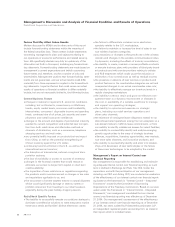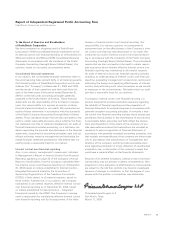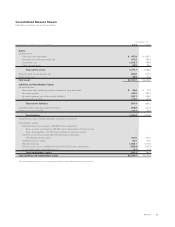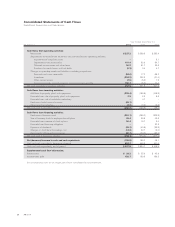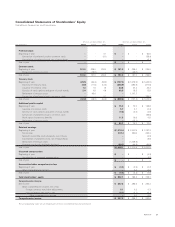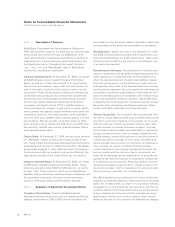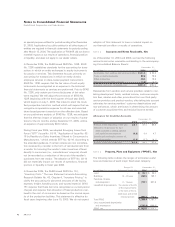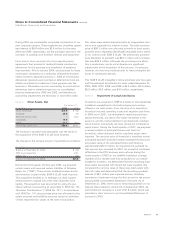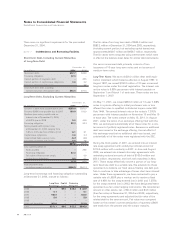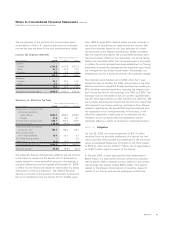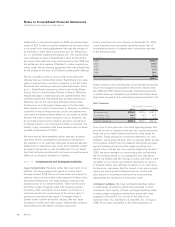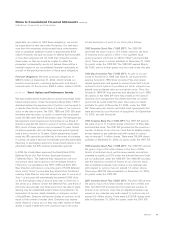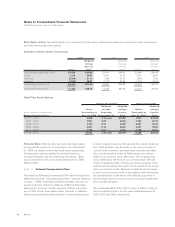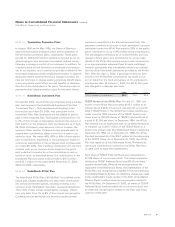Radio Shack 2004 Annual Report Download - page 44
Download and view the complete annual report
Please find page 44 of the 2004 Radio Shack annual report below. You can navigate through the pages in the report by either clicking on the pages listed below, or by using the keyword search tool below to find specific information within the annual report.
adoption of this statement to have a material impact on
our financial condition or results of operations.
NOTE 3 Accounts and Notes Receivable, Net
As of December 31, 2004 and 2003, we had the following
accounts and notes receivable outstanding in the accompany-
ing Consolidated Balance Sheets:
December 31,
(In millions) 2004 2003
Receivables from vendors and service providers
$131.4 $ 92.3
Trade accounts receivable 80.6 75.6
Other receivables 30.4 18.6
Allowance for doubtful accounts (1.4) (4.1)
Accounts and notes receivable, net $241.0 $182.4
Receivables from vendors and service providers relate to mar-
keting development funds, residual income, customer acquisi-
tion fees, rebates and other promotions from our third-party
service providers and product vendors, after taking into account
estimates for service providers’ customer deactivations and
non-activations, which are factors in determining the amount
of customer acquisition fees and residual income earned.
Allowance for Doubtful Accounts
December 31,
(In millions) 2004 2003 2002
Balance at the beginning of the year $ 4.1 $7.4 $ 6.8
(Recovery of) provision for bad
debts included in selling, general
and administrative expense (0.3) 0.4 4.7
Uncollected receivables written off,
net of recoveries (2.4) (3.7) (4.1)
Balance at the end of the year $ 1.4 $4.1 $ 7.4
NOTE 4 Property, Plant and Equipment (“PP&E”), Net
The following table outlines the ranges of estimated useful
lives and balances of each major fixed asset category:
Range Of December 31,
(In millions) Estimated Useful Life 2004 2003
Land – $ 35.1 $ 35.0
Buildings 10 – 40 years 288.5 169.1
Furniture, fixtures
and equipment 2 – 15 years 704.1 631.8
Leasehold improvements The shorter of the life
of the improvements
or the term of the re-
lated lease and certain
renewal periods 356.7 345.8
Total PP&E 1,384.4 1,181.7
Less accumulated depreciation
and amortization (732.4) (668.6)
PP&E, net $ 652.0 $ 513.1
as special-purpose entities for periods ending after December
31, 2003. Applications by public entities for all other types of
entities are required in financial statements for periods ending
after March 15, 2004. The application of FIN 46R did not have a
material impact on our results of operations, financial position
or liquidity, and does not apply to our dealer outlets.
In December 2004, the FASB issued SFAS No. 123R. SFAS
No. 123R establishes standards for the accounting for trans-
actions in which an entity exchanges its equity instruments
for goods or services. This Statement focuses primarily on
accounting for transactions in which an entity obtains
employee services in share-based payment transactions.
SFAS No. 123R requires that the fair value of such equity
instruments be recognized as an expense in the historical
financial statements as services are performed. Prior to SFAS
No. 123R, only certain pro forma disclosures of fair value
were required. We will adopt the provisions of SFAS No.
123R beginning with the third quarter of fiscal year 2005,
which begins on July 1, 2005. We intend to elect the modi-
fied prospective transition method which will require that we
recognize compensation expense for all new and unvested
share-based payment awards from the effective date. Based
on our preliminary analysis of SFAS No. 123R, we anticipate
that the after-tax impact of adoption on our results of opera-
tions for the six months ending December 31, 2005, will be
an expense of approximately $6.8 million.
During fiscal year 2004, we adopted Emerging Issues Task
Force (“EITF”) Issue No. 03-10, “Application of Issue No. 02-
16 by Resellers to Sales Incentives Offered to Consumers by
Manufacturers,” which amends EITF No. 02-16. According to
the amended guidance, if certain criteria are met, considera-
tion received by a reseller in the form of reimbursement from
a vendor for honoring the vendor's sales incentives offered
directly to consumers (i.e., manufacturers' coupons) should
not be recorded as a reduction of the cost of the reseller's
purchases from the vendor. The adoption of EITF No. 03-10
did not materially impact our results of operations, financial
position or liquidity in fiscal year 2004.
In November 2004, the FASB issued SFAS No. 151,
“Inventory Costs.” The new Statement amends Accounting
Research Bulletin No. 43, Chapter 4, “Inventory Pricing,” to
clarify the accounting for abnormal amounts of idle facility
expense, freight, handling costs, and wasted material. SFAS
151 requires that these items be recognized as current-period
charges and requires that allocation of fixed production over-
head to the cost of conversion be based on the normal capac-
ity of the production facilities. This statement is effective for
fiscal years beginning after June 15, 2005. We do not expect
Notes to Consolidated Financial Statements
RadioShack Corporation and Subsidiaries
42 AR2004


